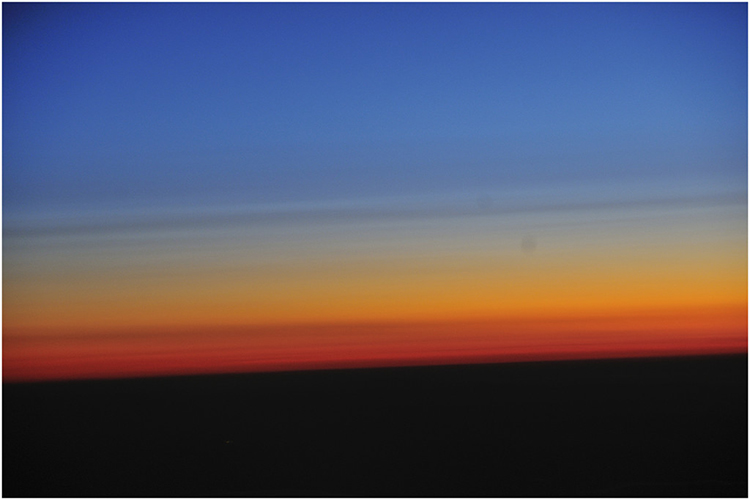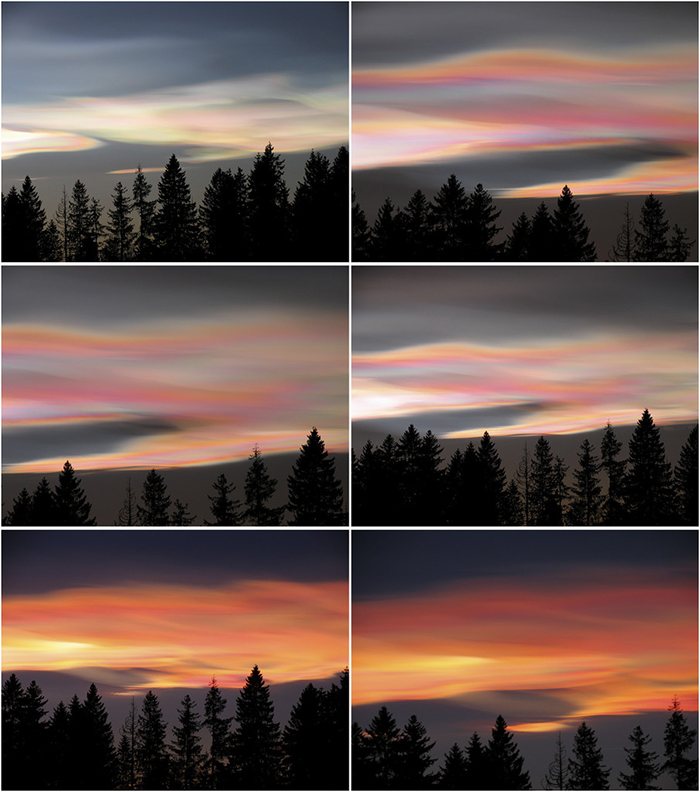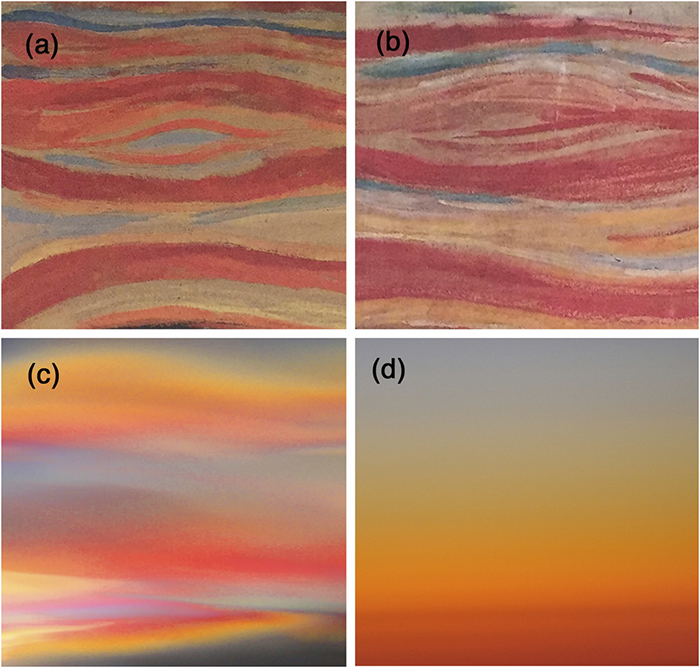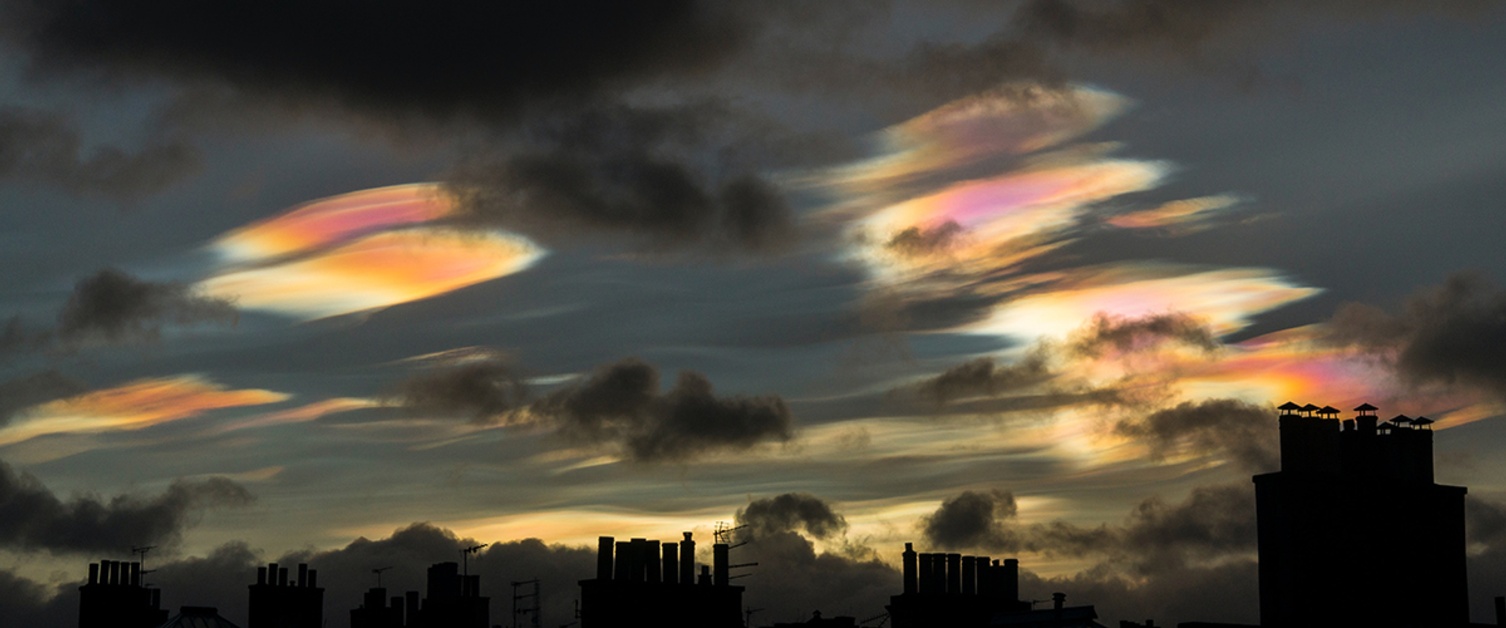Decoding the Sky: Identifying Clouds in Edvard Munch's The Scream
- By Fred Prata, Alan Robock, and Richard Hamblyn
- Jun 8, 2021
Photo by Ben Jessop
Art has an interesting role to play in weather observing. Paintings, sketches, and other media can provide representation of clouds and other meteorological phenomena from before measurements and data collection instruments were standardized and widespread. William Ascroft’s pastel sketches from 1888 are an example of this. These sketches depict observations from Chelsea, London, on 26 November 1883 and show the effects of the eruption of Krakatau. The images capture the impact that aerosols high in the atmosphere have on the color of the sky.
Luke Howard’s systematic categorization of clouds in the 1800s also showed how art could walk hand in hand with science. Clouds had hitherto been assumed to be ephemeral shapes in the sky. With his descriptions and sketches of different cloud types, Howard had an immediate impact on the scientific community and these representations were recognized at the time as an important paradigm for data collection.
These examples were obviously connected to scientific societies and observations. But could one of the most famous paintings in the world provide insights into 19th century meteorological observations? Edvard Munch’s painting The Scream, has been the subject of much debate and discussion since its completion. Not the least of its mysteries is the bright red sky that occupies much of the image.
The Art of Edvard Munch
Edvard Munch (1863–1944) was a Norwegian artist noted for his somber motifs and expressionist style. His mother died in December 1868 of tuberculosis, a fate also suffered by his grandfather, Edvard Storm Munch, who was insane at the time of his death. The hardships, grief, gloominess, and Edvard’s conviction that he would eventually succumb to insanity are believed to have influenced his artistic style and subject matter. Indeed, the themes of blood and melancholy are present in many of his paintings.

Four versions of The Scream. From left to right: 1893 tempera on cardboard, 1895 pastel on cardboard, 1910(?) tempera on hard cardboard, and 1893 crayon on cardboard.
The Scream
The most famous, certainly the most iconic, of Munch’s works is The Scream. The image has been reproduced many times and copied by other artists such as Andy Warhol and the cartoonist Gary Larson. There are four known color versions of The Scream, all believed to have been produced between 1893 and 1910, and one lithograph produced in 1895.
The Scream also comes with a narrative that Munch himself wrote. It was found in a diary dated 22 January 1892. There are actually several versions of this narrative written in Norwegian and in French, and the one given below is from the English translation of his selected prose (Guleng 2011, p. 276):
I was walking along the road with two friends
—the sun was setting
—I felt a wave of sadness—
—the Sky suddenly turned blood-red
I stopped, leaned against the fence
tired to death—looked out over
the flaming clouds like blood and swords
—the blue-black fjord and city—
—My friends walked on—I stood
there quaking with angst—and I
felt as though a vast, endless
scream passed through nature.
It is unclear whether this description can be treated as an actual observation (a real event)—Munch often added prose statements1 to accompany his art and they exist in many different versions. Although there is no definitive evidence that this event actually happened, there are circumstantial clues that point to a physical location for the walk that fit well with the scene depicted in The Scream as well as with the prose commentary. There is a road near the city of Oslo in a commune called Ekeberg, close to Utsikten, that overlooks Oslo Fjord and has a view toward the southwest in the direction of the setting sun during the winter months. The location is now marked by a commemorative plaque to honor Munch.
At the time that Munch may have made this walk, the road was a path and, interestingly, a slaughterhouse and a mental asylum were located nearby. It has been suggested that the idea of The Scream may have been influenced by the sound of animals being slaughtered nearby. A possible reason for Munch walking in this area, suggested by Sue Prideaux in her book Edvard Munch: Behind “The Scream” (Prideaux 2012), is that he was visiting his younger sister who had recently been admitted into the asylum. There are also speculations that Munch had seen an exhibit of a Peruvian mummy in Paris and this has influenced the way the main figure in The Scream is depicted, with a hairless, contorted face.
The world of art history makes little comment on such influences and there is virtually no analysis of the sky in The Scream. If the narrative is to be treated literally, then there are some important remarks that provide clues to the cause of the dramatic sky. He mentions the sun was setting and that the sky “suddenly” turned blood red. He mentions “flaming clouds” and “swords.” The word “wave” appears in the written statement and the sky is depicted as “wavy.” This suggests that if the observation is to be treated as real, then it is likely that the colors were influenced by an appearance of clouds.
Although many people look at the painting and think that the character is screaming, due to the open mouth, it is clear from Munch’s narrative that it is the sky that is screaming, and the figure is covering his or her ears in a futile attempt to smother the sound. Munch used the same setting to produce other paintings with the same red and yellow sky, mountains, and Oslo Fjord in the background, such as Despair in 1892, another Despair in 1894, and Anxiety, also in 1894. In these paintings, the sky has a much less wavy character, and the sky just curves to exactly match the mountains beneath. This lends some weight to the argument that Munch’s skies reflect real world events of some type or at least represent different types of cloud shapes.
Could This Be a Volcanic Sunset?
The idea that the sky in The Scream was inspired by a volcanic sunset is pervasive; a web search for The Scream will most often include a reference to a volcanic connection. Indeed, volcanic aerosols high in the atmosphere (typically 20 km or higher) produce some of the most spectacular red sunsets. The processes leading to highly reddened skies after the sun has set are well known and involve selective scattering of light. Sulfur dioxide (SO2) emitted during volcanic eruptions is converted to sulfate aerosols that form stable layers in the lower stratosphere. These high-altitude layers contain millions of small-sized aerosols that can scatter light, and due to these aerosols have a different appearance to ordinary sunsets.
Volcanic sunsets get progressively stronger as the sun sinks lower below the horizon, and then they diminish as the sunlight is eclipsed by the Earth and the light rays no longer reach the layer. The dramatic effect can last for 20 minutes or longer, and the speed of onset depends on the latitude of the observer: the sun sets faster at the equator than at 60°N. The image below shows a photograph of a volcanic sunset captured from an aircraft flying at 38,000 ft (11,582 m) over the South Pacific in July 2011, following the eruption of Puyehue-Córdon Caulle (PCC) in southern Chile. This photograph has been selected because it illustrates all the main features of a volcanic sunset that show the strong reddening of the sky near the horizon (in shadow), changing through orange to yellow and finally to the deep blue of the outer atmosphere. There are noticeable stratifications, due to aerosol layers.

Volcanic sunset of the South Pacific due to aerosols from the PCC eruption, southern Chile, on 5 Jun 2011. Photograph taken by F. Prata on 11 Jul 2011.
The question of whether Munch could have seen a sunset affected by the eruption of Krakatau has been raised many times. The sunsets were most vivid in the winter of 1883 over Europe and though the set of observations available is limited, it clearly shows that Krakatau optical phenomena could have been seen from southern Norway at the start of the winter of 1883. There are observations of “glows” on 29 and 30 November 1883 from Kristiania and these continued until February 1884, although there are no specific dates given. The glows are reported to have diminished by March 1884 in Europe. It is highly unlikely that Krakatau optical phenomena would have been visible as late as the 1890s over southern Norway.
The Potential of Nacreous Clouds
So what could be represented in the blood-red sky of The Scream? One study from Fikke et al. (2017), argues that the appearance of nacreous clouds, a very dramatic phenomenon and hardly known at the time, could have caused such a sky. Nacreous clouds are known by atmospheric physicists as one type of polar stratospheric clouds (PSCs) and by the more descriptive moniker of mother-of-pearl clouds (MPCs). Nacreous clouds generate very dramatic skies and are most noticeable as the sun sets, when the color of the clouds reddens and could certainly be described as “blood red,” as the photographs shown later demonstrate. They are visible from southern Norway in winter and Munch had ample opportunity to see such a display. When not traveling abroad, he lived in southern Norway, and the direction and location of the scene depicted in The Scream fits with the direction and location for nacreous cloud observations.
Mohn (1893) describes observations of nacreous clouds made in 1892 from England and Norway, while Størmer (1929) discusses these clouds in a systematic manner from a series of photographs made from sites in Oslo, southern Norway, in 1926. Størmer (1929) notes that between 1872 and 1892 nacreous clouds were observed from Norway, but that after 1893 he did not observe them again until 1926, despite careful observations. Stanford and Davis (1974) provide a list of dates when these clouds were observed from Europe; in 1892 there are five confirmed observations from Norway, and there are observations in every year before that until 1881, except 1883 and 1888. While it is generally considered that these clouds are rare, apparently from the right location (southern Norway) and at the right time of year (winter) there is a good chance of observing them. Munch therefore likely had the opportunity to witness a nacreous cloud display from exactly the location that he made his walk with his two friends, looking in the right direction toward the southwest during many days in most of the winters between 1872 until 1892. In the 1880s and 1890s, these clouds had not been classified and their height and occurrence were unknown.
Earliest Documentation of Nacreous Clouds
The earliest photographs of nacreous clouds are given by Størmer (1926), and there are numerous examples of photographs of these clouds now available on the web. The website www.atoptics.co.uk has some striking examples of nacreous clouds, and the recent article by Fikke et al. (2017) also includes some fine examples. In January 2008 there was a particularly vivid display of these clouds, and one of us (F.P.) was lucky enough to be in southern Norway (Leirsund, ∼60°N, ∼11°E) and make a series of photographs looking toward the southwest as the sun set. The change in the appearance of the clouds as the sun disappeared below the horizon was remarkable: the sky reddened and the full spatial extent of the clouds became more evident. Part of the series of photographs is shown in chronological order below. Before sunset, the clouds appeared cirruslike; white with only a hint of the spectacular colors to come. A short time later, as the light diminished, hues of blue, green, pink, and red began to emerge. The wavy nature of the clouds became clearer and the progression of colors followed an intermittent pattern with blues and reds mixed in a wavelike structure. Finally, as the sun set the clouds became reddened, appearing very bright and vivid but with the wavelike nature still noticeable.

Series of photographs of nacreous clouds taken on the evening of 20 Jan 2008 from Leirsund, southern Norway (photographs taken by F. Prata).
A comparison between a section of the sky in The Scream (two versions), a section from a photograph of nacreous clouds, and a section from the Puyehue-Córdon Caulle photograph are provided in the images below. While all four panels show reddened skies, there is a striking resemblance between the skies of The Scream and those of the nacreous clouds, in pattern and color structure. The waviness in the sky in The Scream is absent in the volcanic sunset. The alternating patterns of colors in The Scream are evident in the nacreous cloud photograph, and there is no uniform progression of color from red to deep blue in The Scream that is so clear in the Puyehue-Córdon Caulle sunset. The “eyelike” structure as seen in the figure below is often noticeable in nacreous cloud photographs.
What more appropriate sight in the sky could there have been to ignite Munch’s morbid thoughts than a turbulent cloud structure full of reds and oranges? There is a certain iridescence in nacreous clouds that is not reproduced in The Scream. This could be because of the limited materials available to Munch [see Singer et al. (2010) for a detailed analysis], or because after sunset the iridescence is less pronounced (see the bottom two photographs above). The Scream has never been restored (Ydstie 2008), and it must have been much brighter when first produced. Singer et al. (2010) analyzed the pigments used in several of Munch’s paintings including both versions of The Scream. They found that Munch’s palette was not extensive and also that some of his paintings were left outside, suggesting that they were deliberately left to “weather.” The original paintings may have been more vibrant than what we see now. Nevertheless, the main features that separate nacreous clouds from all other types, the progression of colors, the waviness, and their appearance after sunset, suggesting great height, are all captured in the sky over Oslo Fjord as depicted in The Scream.

Intercomparison of part of the sky in The Scream with nacreous clouds and a volcanic sunset: (a) section from the 1910 version, (b) section from the 1893 version, (c) section from a photograph of nacreous clouds, and (d) section from a photograph of a PCC sunset.
If Munch did indeed observe and then paint the sky in The Scream based on a nacreous cloud display, then this in all likelihood would represent the first graphical depiction of a type of cloud largely unknown to meteorology at the time. In this context, this hypothesis will be relevant to those interested in clouds and in historical aspects of the development of cloud science in meteorology.
This article has been edited and condensed specifically for the AMS Weather Band from a longer version in the Bulletin of the American Meteorological Society. Any errors or omissions may be attributed to AMS Staff. Copyright remains with the AMS.
